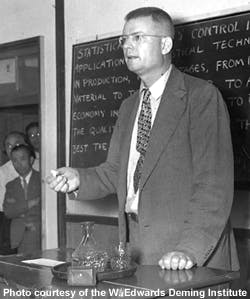In traditional safety management, the theory of accident prevention is based on the work of H.W. Heinrich. In his seminal 1931 book "Industrial Accident Prevention: A Scientific Approach," Heinrich wrote that "88 percent of all industrial accidents are caused by the unsafe acts of persons."
Heinrich was one of the first safety professionals to apply science to accident prevention. He also developed theorems for whyHeinrich recognized the management parallel between quality and safety. His seventh axiom of industrial safety states: "Methods of value in accident prevention are analogous with the methods required for the control of quality, cost and quantity of production."
Much has changed in quality management theory since the 1950s. But we have been applying Heinrich's safety management theory uncritically since then. To this day, professional safety management maintains a focus on changing the behavior of workers.
While safety theory has remained stagnant, quality theory has made major advancements since the 1950s. When Dr. W. Edwards Deming's management theory and his system of profound knowledge are applied to safety management, safety performance will improve.
Focusing on the System
Deming's approach will help management understand why the majority of employee accidents are caused by the system itself – not by the action(s) of individuals. Management also will stop focusing on the outcomes of the system, because it's not as effective as working on the causes of the outcomes. What's most important for safety leadership is to determine whether an accident is a product of the system or an anomaly.
Deming attributed 96 percent of most problems – and possibilities for improvement in a system – to the system itself (the responsibility of management) and 4 percent to special causes. When it comes to accidents, he said the proportion could be higher.
This contradicts Heinrich's theory.
Deming used the equation x + (yx) = 8 to expose the fallacy of ranking the performance of people, where x is the contribution of the individual, (yx) is the effect of the system on the person's performance and 8 is a hypothetical number for an apparent result. To solve the equation, Deming theorized, we need x. But we cannot determine x, the effect an individual has on the entire system, nor (yx), the effect the system has on the individual. The equation isn't solvable.
Managers who use the merit system to rank people think they're solving the equation for x. They ignore the other term (yx), which is predominant. Using Heinrich's theory, safety management commits the same mistake.
Deming's equation is useful to show the futility of trying to explain the cause of an accident when the apparent performance actually is attributable mostly to the interaction between workers and the system. Prior to his theory, management blaming individuals for quality defects was the norm. This change in thinking created a new quality paradigm enabling companies to achieve quality levels previously unattainable. It will do the same for safety.
Applying the equation to safety, x is the contribution of the individual to safety on the work system and y is the effect of the interaction between the system and the individual. Both x and (yx) are different from person to person.
Again, we can't determine x, an individual's contribution to safety in his or her job. At best, it only can be minimal and mostly undiscoverable. Individual workers do not determine the speed of production; the quality and amount of safety training administered; the daily attitudes of their supervisors toward safety; the maintenance of machinery and equipment; the layout of the job process; the work environment (temperature, comfort); the use of fear to manage safety; and the organization's safety culture.
Deming called these continual factors in the work system "common causes." We do know common causes are responsible for the majority of the outcomes of any work system. This includes safety.
There are other problems when applying the unsafe-action theory to accidents. The biggest reason for failure in problem-solving comes from assuming a causal connection between variables when they only have been demonstrated to be associated. The fact is unsafe actions are just one of many variables associated with accidents.
Understanding Common Causes
The flaw in the unsafe-action theory is the mislabeling of a symptom – "unsafe act," which is an indicator of a threat to the health of an organism – as a cause. Then it assumes cause and effect must be closely connected in time and space. It doesn't account for separation of time and space between cause and effect, so it ignores all other factors of the system.
In reality, cause and effect often are hidden and difficult to discern, precisely because they're not always closely connected in time and space. The intended and unintended effects of actions often are delayed.
It's been said that common causes show up later as special causes. There are many different variables involved directly and indirectly related in time and space that contribute greatly to the causes of an accident. Consequently, even though people instinctively avoid pain and do their best to avoid accidents, accidents happen. Lucky for most of us, accidents are rare events. But best efforts cannot overcome fundamental flaws in a system.
For instance, management assumes that once people have attended a safety training class, everyone absorbs the knowledge and will use it from that point on. Human beings just don't function this way. We forget things over time, and safety training is no exception. Some will remember and apply it for a long period of time; others not so much. This is a common cause in the system.
But probably the most important common cause of accidents is the subtle (and at times not so subtle) use of fear in work systems. When applied in safety, fear causes workers to retreat from participating in communications with management. They shy away from telling management about things that are wrong. It's not unusual for hourly workers to learn that it's dangerous to bring safety problems to the attention of management. Their suggestions are either ignored, pushed up the organization and disappear or overridden.
Eventually, workers put themselves in even greater danger by trying to do their best using riskier alternatives rather than talking to their bosses about safety issues. When they're involved in an accident, they've set themselves up to be the cause of it and can't defend their actions – and a common cause becomes a special cause.
All of these things and more are common causes of accidents – no one thing is the root cause. Ultimately, the non-sequential interactions of common causes produce accidents. Luckily, most of the time the interactions cancel each other out and nothing goes wrong. As a result, employee accidents are not a normal or frequent event.
The fact that accidents are relatively rare events should remind us that the absence of a negative does not always mean you have a strong positive. In reality, common causes are hidden in plain sight. You can observe a factory setting for hours and not be able to see everything that's happening behind and around the scenes.
Every manager I've worked with agrees with me when I say that hourly workers know more about safety issues and problems than anyone else in the organization. But when you ask them what that means and what they're doing about it, they can't provide an answer. It's easy to agree with something you don't truly understand. But how could they know?
Safety management would be better-served by spending more time and effort heeding Dr. Deming's advice. We need to go far beyond common sense and seek to understand common causes – and fix the system instead of the worker.
Thomas A. Smith ("Smitty") is the author of "Systems Accidents: Why Americans Are Injured At Work And What Can Be Done To Stop It." He can be reached at [email protected] or at (248) 391-1818.

